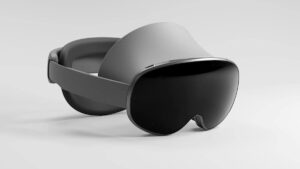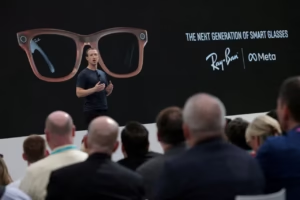Wearable technology has come a long way, from the first fitness trackers to the sleek and multifunctional smartwatches and augmented reality (AR) glasses of today. As we move into a new era of innovation, wearable tech is expected to evolve in ways that will transform our daily lives, from enhancing health and fitness to improving connectivity and productivity.
In this article, we will explore the future of wearable technology, highlighting the trends and innovations that will shape the next generation of devices.
1. Health and Wellness Integration
Advanced Health Monitoring
Health and wellness have always been at the forefront of wearable technology, but the next generation of devices will bring even more sophisticated capabilities. While wearables like Apple Watch and Fitbit already track basic metrics such as heart rate, sleep, and activity levels, future devices will go far beyond.
- Blood Oxygen and Blood Pressure Monitoring: New wearables may integrate more advanced sensors to track blood pressure and blood oxygen levels continuously. These features could help prevent medical emergencies by providing real-time health insights.
- Continuous Glucose Monitoring: Devices like smartwatches and patches could soon monitor glucose levels in real-time, making them invaluable tools for people with diabetes.
- Mental Health Tracking: With AI-powered sensors and apps, wearables could help monitor signs of stress, anxiety, and depression, providing early intervention and mental wellness support.
Wearable Diagnostics
In the future, wearables could become diagnostic tools. Devices might integrate with healthcare systems to provide in-depth health assessments, identifying potential risks and suggesting lifestyle adjustments.
2. Augmented Reality (AR) and Virtual Reality (VR)
AR Glasses
While companies like Meta and Microsoft have already introduced AR glasses, the technology is still in its early stages. In the coming years, expect to see AR glasses that offer seamless integration with everyday life. These glasses could display real-time information on everything from navigation directions to text messages.
Key developments in AR for wearables include:
- Improved Visual Quality: Expect high-resolution displays that deliver crisp, lifelike visuals.
- Hands-Free Operation: AR glasses may become more intuitive, responding to voice commands, gestures, or eye movements to provide a truly hands-free experience.
- Enhanced Social and Work Interactions: Imagine attending virtual meetings or collaborating with colleagues in a mixed-reality workspace, all through your AR glasses.
VR for Fitness and Entertainment
As VR technology advances, we will likely see wearables integrated with VR headsets for more immersive experiences in gaming, education, and fitness. These devices will offer deeper immersion in virtual worlds, allowing for hands-on training, simulations, and entertainment.
3. Fashion and Personalization
Smart Fabrics
The future of wearables won’t just be about gadgets; it will also involve smart clothing. Smart fabrics and textiles will embed sensors directly into clothing, offering a host of features like body temperature regulation, muscle recovery support, and even heart rate tracking.
For example:
- Smart activewear could help athletes optimize their performance by tracking muscle strain and fatigue.
- Fashionable wearables could integrate subtle technology, blending style with functionality. Expect to see smart jewelry, fashionable smartwatches, and LED-lit accessories that track your fitness while complementing your style.
Customization Through AI
Future wearables will feature even more personalization, powered by AI. Devices will adapt to a user’s behavior and preferences, offering insights into health, fitness, and productivity that are tailored to the individual. AI will learn from the user’s daily routines, adapting features and notifications accordingly.
4. Improved Connectivity
5G and Beyond
As 5G networks continue to expand, wearables will become even more connected. High-speed internet and ultra-low latency will make it easier for devices to interact with each other and access cloud-based services in real time. This means wearables will be able to stream high-quality media, deliver real-time data analysis, and even support remote health monitoring for healthcare professionals.
Advanced Biometric Authentication
The future of wearables will likely feature more advanced biometric authentication methods. Smartwatches, rings, or even glasses could incorporate facial recognition, voice recognition, and fingerprint scanning to offer enhanced security for payments, digital access, and personal data.
5. Energy Efficiency and Sustainability
Battery Life and Charging Innovations
One of the biggest challenges for wearable tech has been battery life. Future devices will likely feature longer battery life and faster charging capabilities, possibly through more efficient solar charging or wireless charging. This could make wearables more convenient and reliable, reducing the need for frequent charging.
Sustainability
With growing concerns about e-waste, the future of wearable technology will focus on sustainable materials and eco-friendly designs. Expect to see wearables made from recyclable and biodegradable materials, reducing their environmental impact.
6. Security and Privacy
As wearables collect increasingly sensitive personal data, such as health metrics and location information, privacy and data security will become even more important. Future wearables will likely come equipped with advanced encryption and privacy-focused features to ensure that personal data is protected at all times.
Conclusion: The Future of Wearable Technology
The future of wearable technology is incredibly promising, with advancements in health monitoring, AR/VR, fashion, and connectivity all on the horizon. As the industry continues to innovate, we can expect wearables to become not only essential tools for daily living but also extensions of our own capabilities.
The next generation of wearables will offer more than just convenience; they will help us monitor our health, improve productivity, and engage with the world in entirely new ways. Whether you’re a fitness enthusiast, tech lover, or simply someone looking for greater convenience, the future of wearable technology is something to look forward to.














